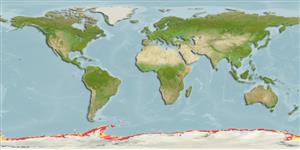Actinopterygii (Straalvinnigen) >
Perciformes (Perch-likes) >
Nototheniidae (Cod icefishes)
Etymology: Trematomus: Greek, trematos = hole + Greek, tomo = section, cut (Ref. 45335); eulepidotus: eu means true + lepidotus means well scaled (Ref. 11892). More on author: Regan.
Issue
This species is placed in the genus Pseudotrematomus in Eschmeyer (CofF ver. Sep. 2011: Ref. 88002).
Omgeving / Klimaat / Range
Ecologie
; marien demersaal; diepteverspreiding 70 - 650 m (Ref. 26875). Polar, preferred -2°C (Ref. 107945); 60°S - 78°S
Southern Ocean: continental shelf of Antarctica and nearby islands, including the South Orkney.
Length at first maturity / Size / Gewicht / Leeftijd
Maturity: Lm 22.0, range 19 - 26 cm
Max length : 34.0 cm TL mannelijk/geslacht niet bekend; (Ref. 5179)
Dorsale stekels (totaal): 6 - 7; Dorsale zachte stralen (totaal): 36-38; Anale stekels 0; Anale zachte stralen: 34 - 36; Wervels: 54 - 57. Second dorsal-fin rays 0-3 more than anal-fin rays. Preopercular-mandibular canal with 10 pores; infraorbital canal with 6-8 pores; supra-orbital canal with 4 pores; coronal commissure with a single median pore; temporal canal with 5-6 pores; supratemporal canal complete wit 3 pores. Body and head almost entirely scaled, including snout, preorbitals, posterior part of maxilla, lower jaw, isthmus, branchiostegal membranes and proximal parts of branchiostegal rays.
Color: In alcohol, ground color buff, with a chequered pattern formed by staggered dark blotches along the dorsal, lateral and ventral parts of the body; ventral dark blotches may appear as short wavy horizontal dark marks. Snout, occipital region and sometimes interorbital area are dark.
Most common in shallower waters of the continental shelf, especially on banks less than 250 m deep in areas where local upwellings increase food supply (Ref. 6390). Juveniles are found near the surface, often in association with Antarctic krill (Euphausia superba) swarms. Feed on salps, nudibranchs, amphipods, copepods, polychaetes, krill, crustaceans, chaetognaths, and fish (Ref. 6390).
Mature females may spawn for the first time from around 7-9 years of age (Ref. 71843).
Dewitt, H.H., P.C. Heemstra and O. Gon, 1990. Nototheniidae. p. 279-331. In O. Gon and P.C. Heemstra (eds.) Fishes of the Southern Ocean. J.L.B. Smith Institute of Ichthyology, Grahamstown, South Africa. (Ref. 5179)
Status op de Rode Lijst van het IUCN (Ref. 115185)
CITES (Ref. 94142)
Not Evaluated
Gevaarlijk voor mensen
Harmless
Gebruik door de mens
Visserij: commercieel
Tools
Speciale rapporten
Download XML
Internet-bronnen
